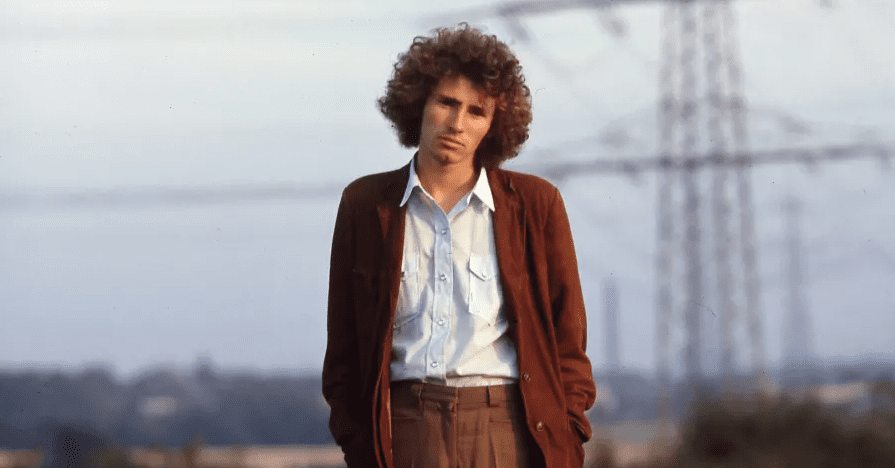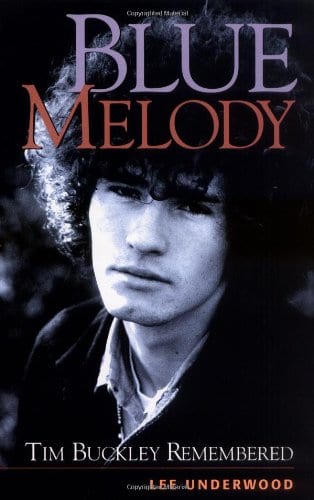Mention the name Tim Buckley in conversation and you can expect only older generations to be familiar with this enigmatic musician. For younger listeners, Buckley remains a bygone name. His tragic death from a drug overdose in 1975 has left his music largely obscured from posterity. One figure who knew Buckley better than most was his close friend and former lead guitarist, Lee Underwood. Underwood has written a biography of Buckley, Blue Melody: Tim Buckley Remembered, the most comprehensive account of Buckley’s enigmatic persona and innovative music, so is the ideal person for me to speak to about Buckley’s trailblazing musical career.
A gifted guitarist and songwriter with a captivating voice, Buckley recorded nine diverse studio albums across his nine-year music career (six of which featured Underwood) diving from one stylistic genre into the next. His musical odyssey began with folk rock and journeyed through the realms of folk-jazz, the avant-garde, funk and soul. Retrospectively, he is overshadowed by his folk contemporaries, such as Bob Dylan and Leonard Cohen, and eclipsed by his more successful son, Jeff, renowned for his famous rendition of Cohen’s ‘Hallelujah’. Sadly, this is often the only musical legacy associated with the Buckley name.
Fortunately, Underwood is bursting with insightful anecdotes regarding his time making music with Buckley, calling from his home in California. Despite Underwood professing that he “was not at all involved in Tim’s songwriting,” Buckley still thrived from Underwood’s rigorous musical background.
“Tim’s mind absorbed information quickly,” Underwood says. “I was older than he, well-read, and well-versed in many different kinds and levels of music. He appreciated that and asked me questions, and immediately absorbed the information and insights I provided.”
Underwood explains that Buckley’s musical interests at the time of his 1966 self-titled debut revolved around country singers Merle Haggard, Hank Williams and crooning icon, Johnny Mathis, as well as the epochal folk rock scene fronted by Bob Dylan. Yet Buckley was an ardent musical apprentice. The music that he digested from Underwood included guitarists Chet Atkins and Bill Haley; jazz pianists Dave Brubeck and Lennie Tristano; and classical composers Beethoven, Bach and Chopin. No wonder, then, that Buckley’s discography metamorphosed through so many genres and styles.
Another integral figure of the Buckley contingent was his school friend, poet and lyricist, Larry Beckett, who worked closely with Buckley on his first two albums, then intermittently from his sixth album, Starsailor (1970) onwards. Underwood praises Beckett as “a most intelligent, sensitive, insightful poet…, especially attuned to some of the great classical poets”, citing Shakespeare and Homer as influences: “Larry’s contributions had a power and beauty and grace of their own, which Tim appreciated.”
This power, beauty and grace is distilled in the title track to Buckley’s second album, Goodbye and Hello (1967), where Underwood calls Beckett’s lyrics “brilliant as literature in and of themselves”. The song’s grandiose imagery flickers with regal and theatrical vignettes of love and violence. Beckett’s lyrics are more socially conscious on the pacifistic, ‘No Man Can Find the War’. Ironically, Beckett soon became absent due to military service, though he would return as Buckley’s intermittent collaborator from his sixth album, Starsailor (1970), onwards. This gave Buckley the opportunity to come into his own as a lyricist on his next three albums, where his songwriting became more romantic and introspective, veering away from Beckett’s more political writing.
Both Underwood and I agree that Buckley’s third album, Happy Sad (1969), is our favourite chapter of his discography. Buckley mellowed and refined his sound into a beautiful folk jazz aesthetic, with the interplay between Underwood’s lead guitar and David Freidman’s vibraphone producing mesmerising sonic textures, while extra warmth emanated from John Miller’s acoustic bass. A standout song for Underwood is ‘Love from Room 109’, a gorgeous ten-minute suite awash with the sound of ocean waves, and alive with the nostalgia of a coastal romance.
Nevertheless, the album’s enchanting beauty is only one aspect of its significance; it also features the first instance of Buckley’s dabbling experimentation. “With the song ‘Gypsy Woman’, Tim began to stretch out,” explains Underwood. “He began exploring new ways of using his voice, not merely as a vehicle to carry love song lyrics, but as an instrument in its own right.” This is evident upon listening to the frantic extended jam, which dominates the second side of Happy Sad. Buckley’s volatile voice dances between frenzied falsetto runs and longer, more restrained tones.
‘Gypsy Woman’ is merely the first of countless examples of Buckley’s most celebrated musical asset—his spellbinding vocal talents. “He was original, unique, and vocally far more complex and capable than the rock and jazz vocalists of the day”, says Underwood.
Bruce Mueller, who saw Buckley perform live on three occasions, similarly claims that his voice “stands comparison with any voice of the 20th century, including jazz and opera singers”.
Buckley’s musical sophistication began to grow with his discovery of jazz legends Miles Davis, Bill Evans and Roland Kirk, but escalated with a little help from his trusted musical mentor. Underwood recounts assisting Buckley through his labyrinthine journey into the avant-garde:
“I was into electronic music, and introduced Tim to several modern composers, including Penderecki and especially Luciano Berio and his wife Cathy Berberian. When Tim listened to Luciano and Cathy, he said the electronics did not touch his heart, but he loved Cathy Berberian’s singing. She did not sing words at all, but utilized her voice completely as a sonic instrument—bleeps, squeaks, tongue-twirling, whoops, cries, etc. “In Cathy Berberian,” he said, “I have found a friend.””
Berberian’s expressive vocal influence began to permeate Buckley’s music on his fifth album, Lorca (1970), his first amateurish venture into the musical maze of the avant-garde. But it is Lorca’s successor, Starsailor, which endures as Buckley’s most uncompromising and daring project; few albums have reached such arcane heights of wild experimentation. Almost impenetrable upon first listen, it is the most rewarding challenge for the objective music listener and wholly unique.
“With Starsailor, Tim created an amazing combination of odd-time signatures, avant-garde instrumental music, and astonishing vocal flights that nobody else has come close to before or since,” says Underwood. For many, Starsailor remains Buckley’s magnum opus, an opinion held by Buckley himself. In a poignant recollection, Underwood remembers that in a telephone call shortly before Buckley’s death, he said to him, “Starsailor is my masterpiece”.

Though Starsailor estranged much of Buckley’s audience, it also featured his most commercially successful track, ’Song to the Siren’, and commercial success was exactly what Buckley needed heading into his next album, Greetings from L.A. (1972).
“After devoting three years to “Starsailor music” in a mostly failed effort to develop an audience, he needed to change conceptual directions once again,” says Underwood, “this time into the get-down, funky, fun-time, sex-drenched delights of Greetings from L.A.”. This string of adjectives is testament to the distinctive sound of Buckley’s first foray into what was dubbed “white soul”.
The album’s style stems from Buckley’s love of blaxploitation movies and their accompanying soundtracks. Its cover – a postcard snap of Los Angeles blanketed in a grimy red smog – is indicative of Buckley’s unabashedly lecherous lyrics. However, there were exceptions to this “white soul” aesthetic; ‘Hong Kong Bar’ is a fingerstyle acoustic blues piece, driven by a boxcar-esque rhythm, and showcasing Buckley’s most intimate acoustic guitar work.
Greetings from L.A. is wildly different from any other record in the Buckley canon. It was such a vast stylistic leap that the album required a whole new cast of musicians, nor was it tailored to Underwood’s playing style, so he and Buckley amicably parted ways: “He and I remained good friends until the end of his days.”
Underwood returned on a few of Buckley’s later songs, most notably the Fred Neil cover, ‘Dolphins’, on his eighth album, Sefronia (1973), one of two covers songs to feature on the record. The second was ‘Martha’, with Buckley’s version released just two months after Tom Waits’ original. Buckley’s ninth album, Look at the Fool (1974), would turn out to be his swan song. Partying too hard after a lengthy tour, he died from an accidental overdose of alcohol and heroin on 29 June, 1975, aged 28. Few musicians, who also experienced such an ephemeral career, can boast of leaving behind a discography as eclectic and accomplished as Buckley’s.
Following his split from Buckley’s band, Underwood hung up his guitar and moved into music journalism, writing for several different publications, most notably as West Coast Editor of DownBeat magazine. He has resided in his cherished California for nearly sixty years: “I lived outside of Santa Fe in the mountains for some seven years. I loved the wilderness, the snow, the mountains and streams, but inevitably had to move back to my beloved California.”
Underwood admits that it’s “not easy writing about music”, but undoubtedly loves it. Surprisingly, he doesn’t have much trouble staying at home during the COVID-19 pandemic: “That’s what writers do, yes? So it’s not much of a change of lifestyle for me.” Underwood spends his time writing in his studio, playing piano and watching the odd bit of TV. His final remark is pertinent to the introspective effects of the strange times we are living through: “My adventures today take place within; in the mind, the heart, and on my computer keyboard.”
Underwood’s philosophy of heart and mind illustrates how Buckley’s legacy survives in the fond memories of his contemporaries, but for younger generations it lies dormant in the dusty vinyl crates of independent record shops. It is about time that we unearthed Buckley’s classic records from their hiding places and let the turntable stylus rediscover his musical genius.
Words by Rory Sanger
Support The Indiependent
We’re trying to raise £200 a month to help cover our operational costs. This includes our ‘Writer of the Month’ awards, where we recognise the amazing work produced by our contributor team. If you’ve enjoyed reading our site, we’d really appreciate it if you could donate to The Indiependent. Whether you can give £1 or £10, you’d be making a huge difference to our small team.


Thanks for a beautiful remembrance of Tim Buckley.
I have been reading a lot about Tim Buckley through Lee Underwood. Lee definitely has some fantastic insight, here he is talking about Tim’s legacy in another interview: “He plunged into himself, the world, the music, and every performance with his total being. He gave it all to you and me and his other listeners. Very few people have enough courage or strength to do that. They live timid, driftwood lives, rarely committing themselves to any sort of creative vision. Conformity pays well. Creativity takes risks. So if you ask me, it is people who hold back out of ignorance and fear who make the big mistake, not Tim.” Inspiring stuff! As a 25-year-old singer with an acoustic guitar I am determined to get Buckley’s songs back out there to a younger audience. I’m going to start with Buzzin Fly! Thanks for the article!